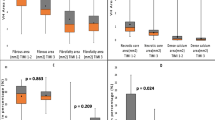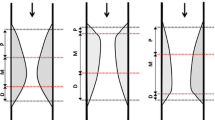Abstract
To use virtual histology intravascular ultrasound (VH-IVUS) to assess the differences in tissue composition between chronic total occlusions (CTO) and non-occlusive lesions, especially in vivo. We compared 50 CTOs (49 patients) after guidewire crossing with 41 non-occlusive lesions (41 patients, 25 with unstable angina and 16 with stable angina). Overall, the percentage of necrotic core in the CTO segments was similar to non-occlusive lesions (35.6 vs. 38.7 %, p = 0.18 at the maximum necrotic core site; 24.2 vs. 23.7 %, p = 0.8 in mean analysis over the entire segment length). However, the percentage of dense calcium in CTO segments was less than in non-occlusive lesions (10.6 vs. 14.8 %, p = 0.025 at the maximum necrotic core site; 7.6 vs. 11.4 %, p = 0.036 in mean analysis over the entire segment length). Finally, the necrotic core/dense calcium ratio tended to be larger in the CTO segment than in non-occlusive lesions (2.94 vs. 2.35, p = 0.082 at the maximum necrotic core site; 3.05 vs. 2.03, p = 0.005 in mean analysis over the entire segment length). Overall, 42 (84 %) CTOs contained a fibroatheroma compared to 40 (97 %) of non-occulsive stenoses. The percentage of necrotic core in CTOs with a fibroathroma (39.0 %) was less than non-occlusive stenoses with a VH-thin cap fibroathroma (44.4 %, p = 0.017) and greater than non-occlusive stenoses with a VH-thick cap fibroathroma (33.5 %, p = 0.022) at maximum necrotic core site. These findings suggest that the morphological characteristics of most CTOs were similar as compared with non-CTO lesions and CTOs evolved from fibroatheromas.

Similar content being viewed by others
References
Kubo T, Maehara A, Mintz GS, Doi H, Tsujita K, Choi SY, Katoh O, Nasu K, Koenig A, Pieper M, Rogers JH, Wijns W, Böse D, Margolis MP, Moses JW, Stone GW, Leon MB (2010) The dynamic nature of coronary artery lesion morphology assessed by serial virtual histology intravascular ultrasound tissue characterization. J Am Coll Cardiol 55:1590–1597
Stone GW, Kandzari DE, Mehran R, Colombo A, Schwartz RS, Bailey S, Moussa I, Teirstein PS, Dangas G, Baim DS, Selmon M, Strauss BH, Tamai H, Suzuki T, Mitsudo K, Katoh O, Cox DA, Hoye A, Mintz GS, Grube E, Cannon LA, Reifart NJ, Reisman M, Abizaid A, Moses JW, Leon MB, Serruys PW (2005) Percutaneous recanalization of chronically occluded coronary arteries: a consensus document: part I. Circulation 112:2364–2372
Mintz GS, Nissen SE, Anderson WD, Bailey SR, Erbel R, Fitzgerald PJ, Pinto FJ, Rosenfield K, Siegel RJ, Tuzcu EM, Yock PG (2001) American College of Cardiology clinical expert consensus document on standards for acquisition, measurement and reporting of intravascular ultrasound studies (IVUS): a report of the American College of Cardiology Task Force on Clinical Expert Consensus Documents. J Am Coll Cardiol 37:1478–1492
García-García HM, Mintz GS, Lerman A, Vince DG, Margolis MP, van Es GA, Morel MA, Nair A, Virmani R, Burke AP, Stone GW, Serruys PW (2009) Tissue characterization using intravascular radiofrequency data analysis: recommendations for acquisition, analysis, interpretation and reporting. Eur Interv 5:177–189
Nasu K, Tsuchikane E, Katoh O, Vince DG, Margolis PM, Virmani R, Surmely JF, Ehara M, Kinoshita Y, Fujita H, Kimura M, Asakura K, Asakura Y, Matsubara T, Terashima M, Suzuki T (2008) Impact of intramural thrombus in coronary arteries on the accuracy of tissue characterization by in vivo intravascular ultrasound radiofrequency data analysis. Am J Cardiol 101:1079–1083
Virmani R, Kolodgie FD, Burke AP, Farb A, Schwartz SM (2000) Lessons from sudden coronary death: a comprehensive morphological classification scheme for atherosclerotic lesions. Arterioscler Thromb Vasc Biol 20:1262–1275
Virmani R, Burke AP, Farb A, Kolodgie FD (2006) Pathology of the vulnerable plaque. J Am Coll Cardiol 47:C13–C18
Hong MK, Mintz GS, Lee CW, Suh J, Kim JH, Park DW, Lee SW, Kim YH, Cheong SS, Kim JJ, Park SW, Park SJ (2007) Comparison of virtual histology to intravascular ultrasound of culprit coronary lesions in acute coronary syndrome and target coronary lesions in stable angina pectoris. Am J Cardiol 100:953–959
Beckman JA, Ganz J, Creager MA, Ganz P, Kinlay S (2001) Relationship of clinical presentation and calcification of culprit coronary artery stenoses. Arterioscler Thromb Vasc Biol 21:1618–1622
Ehara S, Kobayashi Y, Yoshiyama M, Shimada K, Shimada Y, Fukuda D, Nakamura Y, Yamashita H, Yamagishi H, Takeuchi K, Naruko T, Haze K, Becker AE, Yoshikawa J, Ueda M (2004) Spotty calcification typifies the culprit plaque in patients with acute myocardial infarction: an intravascular ultrasound study. Circulation 110:3424–3429
Kimura BJ, Tsimikas S, Bhargava V, DeMaria AN, Penny WF (1995) Subintimal wire position during angioplasty of a chronic total coronary occlusion: detection and subsequent procedural guidance by intravascular ultrasound. Cathet Cardiovasc Diagn 35:262–265
Missel E, Mintz GS, Carlier SG, Qian J, Shan S, Castellanos C, Kaple R, Biro S, Fahy M, Moses JW, Stone GW, Leon MB (2008) In vivo virtual histology intravascular ultrasound correlates of risk factors for sudden coronary death in men: results from the prospective, multi-centre virtual histology intravascular ultrasound registry. Eur Heart J 29:2141–2147
Missel E, Mintz GS, Carlier SG, Sano K, Qian J, Kaple RK, Castellanos C, Dangas G, Mehran R, Moses JW, Stone GW, Leon MB (2008) Necrotic core and its ratio to dense calcium are predictors of high-risk non-ST-elevation acute coronary syndrome. Am J Cardiol 101:573–578
Acknowledgments
Dr. Jun Guo, Dr Ning Guo, Dr. Shang, and Dr. Pu have received grant support from Boston Scientific Corporation, China. Dr. Maehara has received grant support from Boston Scientific Corporation and lecture fees from St. Jude Medical. Dr. Moses is a consultant for Boston Scientific Corporation and Cordis. Dr. Leon is on the advisory boards of Boston Scientific Corporation and Medtronic. Dr. Stone is a consultant to Volcano Corporation. Dr. Mintz has received grant support and is a consultant to Volcano Corporation and Boston Scientific Corporation.
Conflict of interest
Dr. Ochiai is on the speakers’ bureau of Boston Scientific Corporation. Dr. Ashida, Dr. Chirumamilla, Dr. Sanidas, and Dr. Weisz have nothing to disclose.
Author information
Authors and Affiliations
Corresponding author
Rights and permissions
About this article
Cite this article
Guo, J., Maehara, A., Guo, N. et al. Virtual histology intravascular ultrasound comparison of coronary chronic total occlusions versus non-occlusive lesions. Int J Cardiovasc Imaging 29, 1249–1254 (2013). https://doi.org/10.1007/s10554-013-0222-x
Received:
Accepted:
Published:
Issue Date:
DOI: https://doi.org/10.1007/s10554-013-0222-x




